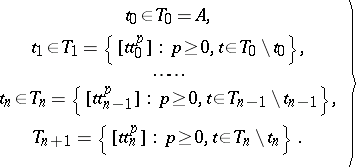Lazard set
A subset  of the free magma
of the free magma  , i.e. the free non-associative structure over
, i.e. the free non-associative structure over  (cf. also Associative rings and algebras). The elements of
(cf. also Associative rings and algebras). The elements of  correspond to completely bracketed words over
correspond to completely bracketed words over  (or rooted planar binary trees with leaves labelled by generators
(or rooted planar binary trees with leaves labelled by generators  ; cf. also Binary tree). These are defined recursively as brackets
; cf. also Binary tree). These are defined recursively as brackets  where
where  are bracketed words of lower weight; bracketed words of weight one correspond to the generators
are bracketed words of lower weight; bracketed words of weight one correspond to the generators  . A subset
. A subset  is said to be closed, if for each element
is said to be closed, if for each element  one has
one has  . Given two elements
. Given two elements  , one writes
, one writes  to denote the element
to denote the element
 |
Consider trees  and subsets
and subsets  defined as follows:
defined as follows:
 | (a1) |
A Lazard set is a subset  such that for any finite, non-empty and closed subset
such that for any finite, non-empty and closed subset  one has:
one has:
 |
for some  , (a1) holds and, moreover,
, (a1) holds and, moreover,  .
.
Lazard sets may be shown to coincide with Hall sets (cf. Hall set). Thus, they give bases of the free Lie algebra over  ; that is, one may associate a Lie polynomial
; that is, one may associate a Lie polynomial  to each element
to each element  of a Lazard set such that the free Lie algebra
of a Lazard set such that the free Lie algebra  (over
(over  ; cf. Lie algebra, free) is freely generated (as a module over a commutative ring
; cf. Lie algebra, free) is freely generated (as a module over a commutative ring  ) by the Lie polynomials
) by the Lie polynomials  . Lazard's elimination process may then be phrased as follows: One has the direct sum decomposition (as a module over a commutative ring
. Lazard's elimination process may then be phrased as follows: One has the direct sum decomposition (as a module over a commutative ring  ):
):
 |
where  is the Lie subalgebra freely generated by
is the Lie subalgebra freely generated by  .
.
Lazard sets were introduced by X. Viennot [a1] in order to unify combinatorial constructions of bases of the free Lie algebra. The Lyndon basis (see Lyndon word) was thought to be of a different nature from the one considered by M. Hall [a2], and generalizations of it were proposed by many authors. Viennot gave a unifying framework for all these constructions. One may present Lazard sets in terms of words, rather than trees in  . It can then be shown that a unique tree structure is attached to every word of a Lazard set. Moreover, a Lazard set of words is totally ordered, as is a Lazard set of trees, and it is a complete factorization of the free monoid. That is, every word is a unique non-increasing product of Lazard words. This result makes explicit the link between bases of free Lie algebras and complete factorizations of free monoids.
. It can then be shown that a unique tree structure is attached to every word of a Lazard set. Moreover, a Lazard set of words is totally ordered, as is a Lazard set of trees, and it is a complete factorization of the free monoid. That is, every word is a unique non-increasing product of Lazard words. This result makes explicit the link between bases of free Lie algebras and complete factorizations of free monoids.
See also Hall word.
References
| [a1] | X. Viennot, "Algèbres de Lie libres et monoïdes libres" , Lecture Notes in Mathematics , 691 , Springer (1978) |
| [a2] | M. Hall, "A basis for free Lie rings and higher commutators in free groups" Proc. Amer. Math. Soc. , 1 (1950) pp. 57–581 |
| [a3] | C. Reutenauer, "Free Lie algebras" , London Math. Soc. Monographs New Ser. , 7 , Oxford Univ. Press (1993) |
Lazard set. Encyclopedia of Mathematics. URL: http://encyclopediaofmath.org/index.php?title=Lazard_set&oldid=14203